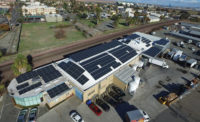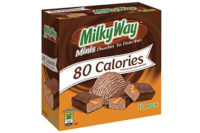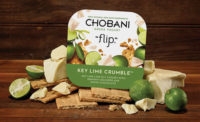Safeway Inc. takes the mystery out of making ice cream. At its Bellevue, Wash., ice cream plant, silos, pasteurizers, stainless steel tubing, flavor vats, fillers and other equipment are all labeled as to their contents or function. There is even a label above a hand-crank pencil sharpener. That was put there either for the benefit of a younger generation raised on hand-held devices (instead of pencil and paper) or else it was an expression of an engineer’s sense of humor.
Michael Williams, plant manager for Safeway Ice Cream in Bellevue, operates the plant according to lean manufacturing principles. The essence of the practice is to preserve value with less work. One of the basic tenets views the spending of resources for any purpose other than the creation of value for the end customer to be wasteful.
Lean manufacturing is seen in Safeway’s adherence to the 5S method: sorting, straightening, systematic cleaning, standardizing and sustaining. These are translated from the Japanese words seiri, seiton, seiso, seiketsu and shitsuke. For example, as practiced in Bellevue, “standardizing” is seen in the blue bulletin boards at each production station. These blue-rimmed boards include a standard operating procedures document. Each board also contains start-up and shut-down procedures, a list of ingredient costs, results from the latest 5S audit report and a photograph showing what a clean station should look like.
Whether Safeway is making ice cream for its own labels or co-packing for others, the first order of business is to produce safe foods, and then to produce them efficiently. Safeway is retail-focused and retail drives the manufacturing, said Randall Dei, director of U.S. ice cream/ industry relations.
The company mission, as stated on signs in the plant, is to “deliver superior service and high-quality products at competitive prices.” To help it achieve the mission, Safeway uses a series of process controls. Since the danger in dairy is non-pasteurized milk and ingredients, pasteurization is a critical control point, said Williams.
“You have control over critical control points. Everything else supports HACCP [hazard analysis and critical control points] — food safety, consumer perception, economical impacts,” Dei said.
The culture at Safeway is to measure everything. That starts at the top, with Steven Burd, the company’s chief executive officer, Dei said. Sharing data is another important behavior in Bellevue. To function as a team, salaried and hourly workers need to know what’s being measured and what the goals are. Dei and the management team write an annual plan for the plant and then they share the costs (but not the profit and loss figures) with employees. The cost of every ingredient in a recipe is available at every ice cream production station in the plant.
Safeway’s adherence to lean manufacturing practices also means it is always seeking to improve. If a production problem arises, a team looks for the root cause. As stated on the mission statement, a goal is to have employees “think like a successful owner.” Managers ask employees for input on best practices. Employee incentives for hitting key performance indicators include gift cards, time off or apparel.
“We empower the employee and give them the infrastructure” to make improvements, added Williams. “The employees help us. They can control waste and overtime costs, for example.” “We don’t tell them” how to do their job, added Tim Hughes, the plant superintendent.
One of the priorities in a lean manufacturing environment is to perform a root cause analysis of production issues. Kaizen (from the Japanese for “continuous improvement”) is a system that encourages every employee in an organization to suggest better ways to get the work done. It is continuous improvement, not a once-a-year activity.
For example, Safeway tracks customer comments about inclusions (or lack thereof) in ice cream. That spurred a kaizen event at the Phoenix plant (see Dairy Foods, May 2009), which Bellevue staff attended. The problem solvers found and implemented solutions, and complaints were reduced by 60%, Dei said.
The Bellevue plant runs two 8-hour production shifts five days a week. The third shift is cleaning. Every shift begins with a review of the previous one. Managers look at various metrics including efficiencies and down time.
“The first hour of performance sets the tone for the whole day,” Dei said. Setting up correctly and starting smoothly set the momentum for the entire shift, he said.
Safeway’s ice cream plant is one building on a large manufacturing campus that includes a fluid milk processing facility, which also produces cottage cheese. All Safeway-branded stick novelties and ice cream cups sold in the United States are manufactured in Bellevue.
The facility also produces ice cream sandwiches, 1.5-quart rounds and 1.5-quart bricks. Besides manufacturing its own brands, this facility co-packs for other dairy brands.
The Bellevue plant was built in the early 1960s and has been upgraded and expanded over the last 50 years. It has six lines — one round 1.5-quart line, one 1.5-quart brick line, two sandwich lines, one stick novelty line and one cup line. During Dairy Foodsvisit, Safeway was making cookies-and-cream ice cream sandwiches, packaged ice cream (in round containers called “cans” and in bricks) and frozen fruit bars.
Cream is piped to the ice cream plant from the fluid milk plant next door. The Seattle-based Darigold dairy cooperative supplies the milk to the milk plant. Tanker trucks deliver condensed skim with 34% solids to the ice cream plant, which is stored in two silos until needed. Safeway also receives tankers of corn syrup blend for sweetening, which also is held in silos.
Safeway makes ice cream mixes a day before they are to be processed so that the mix can age and develop flavor, said Hughes. While the skim and cream have already been pasteurized, they are re-pasteurized with other ingredients when it is time to make the ice cream mix. Safeway uses the high temperature/short time (HTST) pasteurization process.
Before it is processed, a sample of the mix is sent to the on-site lab to be tested for fats and solids. Components of the mix need to be within Safeway’s acceptable parameters; if they are not, water standardization is used to bring the mix within range for fats and solids.
One side of the main processing room is marked “East Sandwich Line” and the other “West Sandwich Line.” Rounds and bricks also are filled in this room. Three 400-gallon flavor vats supply each filling line. Operators at each station measures flavors from plastic jugs into the vats, according to the formula.
On the sandwich line, the filler delivers a portion of ice cream, which is then guillotined to fit the cookies, which are fed by hand into the line. The sandwiches are wrapped in paper and then packaged automatically into cartons, which pass across a checkweigher to assure that the correct count is in each carton. Boxes missing sandwiches are rejected. Then they are conveyed to a second-floor room where individual boxes are bundled into “sellable” units, meaning how the retailer wants to receive them, and then to the freezer for hardening.
On the brick station, flat cartons are formed, and then the package is filled and sealed, then conveyed upstairs. Every line has a sign showing the production capacity. The brick line can produce 3,600 cartons per hour and 57,600 containers per day.
Round cartons, or cans, are filled much like the bricks. The difference is that the round containers are assembled upstairs in a room above the line. An operator feeds blanks into a carton former which forms it into a cylinder. In a separate step, the former adds the bottom. A date and location code is printed on the bottom. The cans and lids are conveyed downstairs to the filler.
In a second production area, Safeway makes stick novelties and fills single-serve ice cream cups. Fruit bars consist of a base of sugar water and fruit mix. Depending on the flavor, a bar could contain chunks of fruit. A filler fills the molds (each containing 14 slots). The bars are static frozen as they move through the brine solution. (In comparison, ice cream is frozen while it is agitated in the freezer, Hughes explained.) As the molds reach the end of the line, they are heated slightly, and the bars are removed by their stick end. Then they are wrapped automatically and packaged by hand. With 14 slots in each mold, the line can make 350 bars every 60 seconds. Hourly output is 21,000 bars.
All of the ice cream products in this room and the other are conveyed upstairs where they are assembled and wrapped into sellable units. The rounds first have a safety seal band applied around the lid and can. A photo eye detects missing bands. The tapered cans are paired off (upside down and right-side up) for more efficient packaging. The ice cream bricks are assembled into six-packs and then overwrapped. The fruit bars are overwrapped in sets of eight or 12. Then all of the products are conveyed to a tri-tray hardening freezer in the warehouse.
Every day in the laboratory, Safeway holds a cutting to test and verify its adherence to quality and manufacturing standards. Quality Manager Darin Huggler leads a quality assurance team through an analysis of the previous day’s production run. Packaged ice cream is butterflied. With the two halves lying side by side, the team performs a visual inspection that considers patterns, texture, consistency and distribution of inclusions. When they evaluate Neapolitan, for example, they look for a clean definition between the chocolate, vanilla, strawberry sections. For the taste test, Huggler first scrapes some ice cream onto a spoon and then rolls it onto another spoon to taste it.
“We test everything,” Huggler said. The tests allow Safeway to isolate and pinpoint the root cause of defects, he said.
Safeway takes a first, random and last sample of every batch and subjects them to microbial testing and performs plate counts. Ingredients, pre-batch mix, works in progress and finished goods are all tested. Additionally, there are also environmental tests performed.
By following the five S’s (sorting, straightening, systematic cleaning, standardizing and sustaining), the Safeway staff in the Bellevue plant avoids a sixth S — Surprises. It is a perfect example of lean manufacturing. Safeway’s retail customers receive value in good-tasting ice cream sold at a competitive price that has been manufactured consistently, batch after batch.
Highlights from Safeway’s Corporate Social Responsibility Report
Supply chain transparency
We’re proud to be a leader in the grocery industry. We actively pursue growth through leadership in environmental, socially responsible and ethical business practices. Corporate social responsibility is at the core of Safeway’s operating philosophy, and it drives our dedication to People, Products, Community and the Planet. It also extends to our supply chain, as our suppliers play a critical role in ensuring that we manage our business in a responsible manner. Safeway asked each of our more than 5,000 suppliers to certify that the materials incorporated into the merchandise they supply Safeway comply with applicable laws regarding slavery and human trafficking. Suppliers are also required to ensure that any subcontractor used in the manufacturing or distribution of merchandise sold to Safeway complies with the same standards.
Animal welfare
We are an industry leader in animal welfare. We believe animals should be raised, transported and processed using procedures that are clean, safe and free from cruelty, abuse or neglect. We partner with independent animal welfare experts and utilize industry best practices to ensure that farm animals are treated humanely at every step from farm to market.
Developing smarter packaging
Our sustainability strategy calls for us to reduce our carbon footprint and support the growth of recycling industries in North America. Packaging innovations can help us meet both objectives. In 2010, we reduced the weight of our Refreshe 500-ml water bottles, conserving approximately 1.2 million pounds of material annually. We also eliminated more than 272,000 pounds of polyvinyl chloride (PVC) from our floral packaging, replacing it with recyclable polyethylene terephthalate (PET) material.
Source: Safeway Inc.
At A Glance
Safeway Inc.,
Bellevue, Wash.
Interstate Milk Shippers plant 53-38
Year plant built/opened: 1960
Size of the plant: 100,000 square feet
Number of production employees in the plant: 100
Products made: Ice cream in 1.5 quart packages, single-serve cups, sandwiches and stick novelties; and fruit bars
Total processing capacity: 50 million pounds annually (Dairy Foods estimate)
Number of shifts: Two production shifts, one cleaning shift
Storage silos: 30
Pasteurization type: High temperature/short time (HTST)
Number of filling lines: Two sandwich lines, one brick line, one round line, one stick novelty line, one cup line
Warehouse size: 50,000 square feet and 500 bays
Safeway’s manufacturing and food processing facilities
U.S. Canada
Milk 6 3
Ice Cream 2 2
Soft Drink Bottling 4 —
Bakery 6 2
Cheese & Meat Packing — 1
Fruit & Vegetable Processing 1 3
Cake Commissary 1 —
Sandwich Commissary — 1 Source: 2011 annual report














